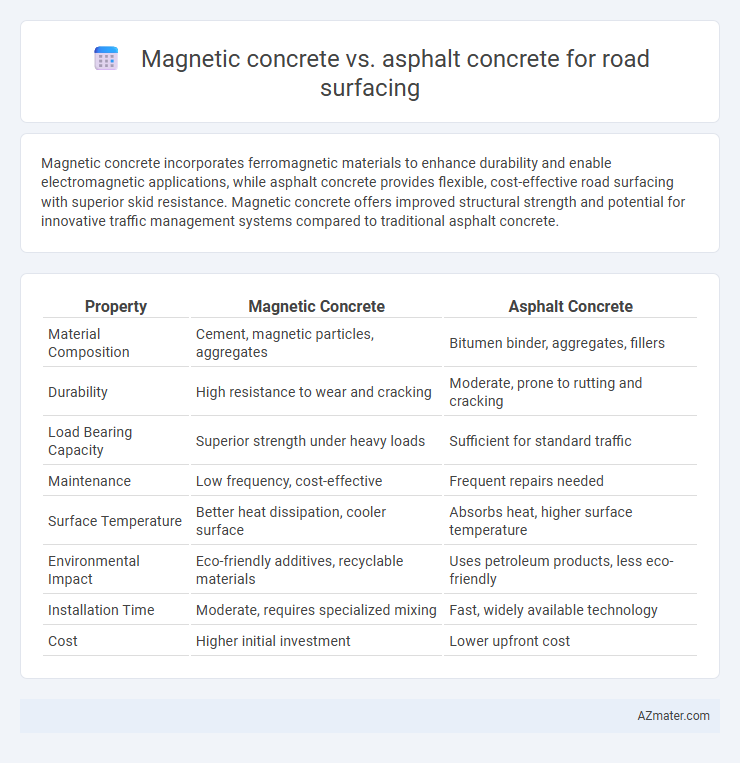Magnetic concrete incorporates ferromagnetic materials to enhance durability and enable electromagnetic applications, while asphalt concrete provides flexible, cost-effective road surfacing with superior skid resistance. Magnetic concrete offers improved structural strength and potential for innovative traffic management systems compared to traditional asphalt concrete.
Table of Comparison
| Property | Magnetic Concrete | Asphalt Concrete |
|---|---|---|
| Material Composition | Cement, magnetic particles, aggregates | Bitumen binder, aggregates, fillers |
| Durability | High resistance to wear and cracking | Moderate, prone to rutting and cracking |
| Load Bearing Capacity | Superior strength under heavy loads | Sufficient for standard traffic |
| Maintenance | Low frequency, cost-effective | Frequent repairs needed |
| Surface Temperature | Better heat dissipation, cooler surface | Absorbs heat, higher surface temperature |
| Environmental Impact | Eco-friendly additives, recyclable materials | Uses petroleum products, less eco-friendly |
| Installation Time | Moderate, requires specialized mixing | Fast, widely available technology |
| Cost | Higher initial investment | Lower upfront cost |
Introduction to Magnetic Concrete and Asphalt Concrete
Magnetic concrete integrates ferromagnetic materials such as iron ore or steel fibers into the cement matrix, enhancing electromagnetic properties while maintaining structural integrity for road surfacing. Asphalt concrete, a traditional composite, consists of mineral aggregates bound by bitumen, offering flexibility, durability, and resistance to weather and heavy traffic. The key difference lies in magnetic concrete's potential for smart infrastructure applications, including vehicle navigation and energy harvesting, contrasting with asphalt's proven performance in standard road construction.
Material Composition and Properties
Magnetic concrete incorporates ferromagnetic materials such as iron filings and steel fibers within the cement matrix, enhancing electromagnetic properties and improving durability through increased tensile strength and crack resistance. Asphalt concrete primarily consists of aggregates bound by bitumen, offering flexibility and excellent waterproofing but lower tensile strength compared to magnetic concrete. The steel fiber reinforcement in magnetic concrete improves load-bearing capacity and wear resistance, making it a potential alternative for high-traffic road surfaces requiring enhanced longevity and electromagnetic functionality.
Structural Strength and Durability
Magnetic concrete exhibits enhanced structural strength due to its improved bonding properties and resistance to cracking compared to traditional asphalt concrete, making it suitable for heavy traffic loads. Its durability is superior, as the embedded magnetic particles contribute to self-healing mechanisms and reduce wear caused by environmental factors such as temperature fluctuations and water infiltration. Asphalt concrete, while flexible and commonly used, tends to deteriorate faster under cyclic loading and extreme weather conditions, requiring more frequent maintenance.
Installation and Construction Processes
Magnetic concrete installation requires embedding iron oxide or magnetic additives into the mix, necessitating specialized mixing and curing techniques to maintain magnetic properties while ensuring structural integrity. Asphalt concrete construction involves heating and applying bitumen-bound aggregates, enabling faster paving and cooling times with conventional equipment. Both methods demand precise layer thickness control and compaction, but magnetic concrete may involve higher initial setup complexity due to its unique material composition.
Environmental Impact and Sustainability
Magnetic concrete offers enhanced durability and reduced maintenance costs compared to asphalt concrete, lowering the environmental burden over the road's lifecycle. Asphalt concrete production releases significant amounts of greenhouse gases and relies on non-renewable petroleum resources, whereas magnetic concrete can incorporate recycled industrial byproducts, minimizing resource depletion. The reduced need for frequent repairs with magnetic concrete further decreases emissions and waste, promoting greater sustainability in road surfacing applications.
Performance in Various Weather Conditions
Magnetic concrete demonstrates superior durability and stability in extreme weather conditions compared to asphalt concrete, maintaining structural integrity under heavy rain, snow, and intense heat. Asphalt concrete tends to soften and deform in high temperatures and develops cracks in freezing weather, leading to costly repairs and reduced lifespan. Magnetic concrete's unique properties enhance resistance to thermal expansion and contraction, resulting in improved performance and longevity for road surfacing in diverse climates.
Cost Analysis and Maintenance Requirements
Magnetic concrete, incorporating magnetite or iron oxide, generally incurs higher initial costs compared to traditional asphalt concrete due to specialized materials and production processes. Maintenance of magnetic concrete is often lower over time, as its enhanced durability and resistance to wear reduce repair frequency and associated expenses. Asphalt concrete requires more frequent resurfacing and crack sealing, increasing long-term maintenance costs despite its lower upfront price.
Magnetic Concrete in Smart Road Technologies
Magnetic concrete integrates ferromagnetic materials that enable electromagnetic interaction, enhancing smart road technologies by facilitating vehicle communication and energy transfer. This innovative material supports real-time traffic monitoring and electric vehicle charging through inductive power transfer embedded within the road surface. Compared to traditional asphalt concrete, magnetic concrete offers advanced functionalities crucial for developing intelligent transportation systems and sustainable urban infrastructure.
Safety Considerations for Road Users
Magnetic concrete enhances road safety by improving vehicle stability through increased traction and better response to braking, especially in adverse weather conditions, reducing the risk of accidents. Asphalt concrete, while widely used, tends to degrade faster under heavy traffic and extreme temperatures, potentially causing potholes and uneven surfaces that pose hazards to drivers and pedestrians. Incorporating magnetic concrete in road surfacing can contribute to safer driving environments by minimizing skidding and enhancing control, particularly on curves and slopes.
Future Prospects and Industry Adoption
Magnetic concrete offers innovative benefits in road surfacing through enhanced durability, smart sensing capabilities, and energy efficiency, positioning it as a sustainable alternative to traditional asphalt concrete. Industry adoption is gradually increasing with pilot projects emphasizing its long-term cost savings and reduced maintenance compared to asphalt's susceptibility to thermal cracking and rutting. Future prospects highlight significant integration potential in smart city infrastructure, supporting real-time traffic monitoring and electric vehicle charging embedded within the pavement.

Infographic: Magnetic concrete vs Asphalt concrete for Road surfacing
 azmater.com
azmater.com